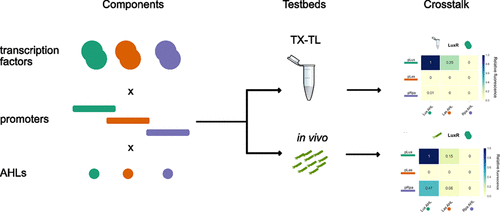当前位置:
X-MOL 学术
›
ACS Synth. Biol.
›
论文详情
Our official English website, www.x-mol.net, welcomes your
feedback! (Note: you will need to create a separate account there.)
Cell-Free and In Vivo Characterization of Lux, Las, and Rpa Quorum Activation Systems in E. coli
ACS Synthetic Biology ( IF 3.7 ) Pub Date : 2017-11-28 00:00:00 , DOI: 10.1021/acssynbio.7b00376 Andrew D. Halleran 1 , Richard M. Murray 1, 2
ACS Synthetic Biology ( IF 3.7 ) Pub Date : 2017-11-28 00:00:00 , DOI: 10.1021/acssynbio.7b00376 Andrew D. Halleran 1 , Richard M. Murray 1, 2
Affiliation

|
Synthetic biologists have turned toward quorum systems as a path for building sophisticated microbial consortia that exhibit group decision making. Currently, however, even the most complex consortium circuits rely on only one or two quorum sensing systems, greatly restricting the available design space. High-throughput characterization of available quorum sensing systems is useful for finding compatible sets of systems that are suitable for a defined circuit architecture. Recently, cell-free systems have gained popularity as a test-bed for rapid prototyping of genetic circuitry. We take advantage of the transcription–translation cell-free system to characterize three commonly used Lux-type quorum activators, Lux, Las, and Rpa. We then compare the cell-free characterization to results obtained in vivo. We find significant genetic crosstalk in both the Las and Rpa systems and substantial signal crosstalk in Lux activation. We show that cell-free characterization predicts crosstalk observed in vivo.
中文翻译:

Lux,Las和Rpa Quorum激活系统在大肠杆菌中的无细胞和体内表征
合成生物学家已将定额系统作为建立复杂微生物联合体的一种途径,该联合体表现出群体决策的能力。但是,目前,即使是最复杂的联盟电路也仅依赖一个或两个法定人数感应系统,极大地限制了可用的设计空间。可用的群体感应系统的高通量表征对于找到适合于已定义电路体系结构的兼容系统集很有用。近来,无细胞系统已成为用于快速构建遗传电路原型的测试床,并逐渐普及。我们利用转录-翻译无细胞系统来表征三种常用的Lux型群体激活因子,Lux,Las和Rpa。然后,我们将无细胞特征与体内获得的结果进行比较。我们在Las和Rpa系统中都发现了显着的遗传串扰,在Lux激活中发现了大量的信号串扰。我们表明,无细胞表征可预测体内观察到的串扰。
更新日期:2017-11-28
中文翻译:

Lux,Las和Rpa Quorum激活系统在大肠杆菌中的无细胞和体内表征
合成生物学家已将定额系统作为建立复杂微生物联合体的一种途径,该联合体表现出群体决策的能力。但是,目前,即使是最复杂的联盟电路也仅依赖一个或两个法定人数感应系统,极大地限制了可用的设计空间。可用的群体感应系统的高通量表征对于找到适合于已定义电路体系结构的兼容系统集很有用。近来,无细胞系统已成为用于快速构建遗传电路原型的测试床,并逐渐普及。我们利用转录-翻译无细胞系统来表征三种常用的Lux型群体激活因子,Lux,Las和Rpa。然后,我们将无细胞特征与体内获得的结果进行比较。我们在Las和Rpa系统中都发现了显着的遗传串扰,在Lux激活中发现了大量的信号串扰。我们表明,无细胞表征可预测体内观察到的串扰。











































 京公网安备 11010802027423号
京公网安备 11010802027423号